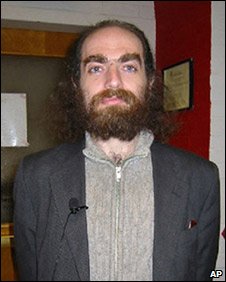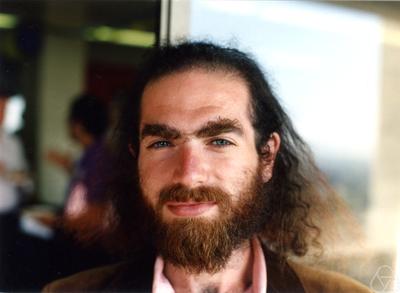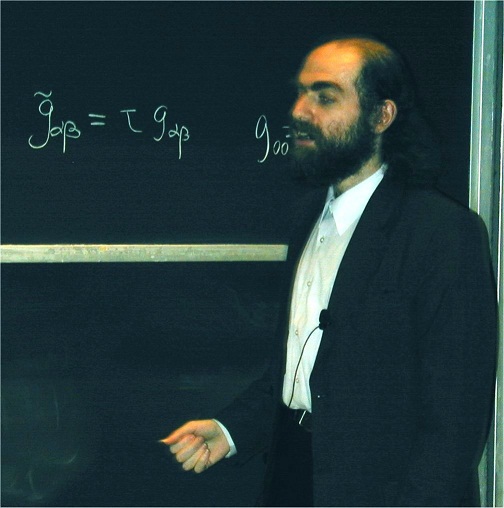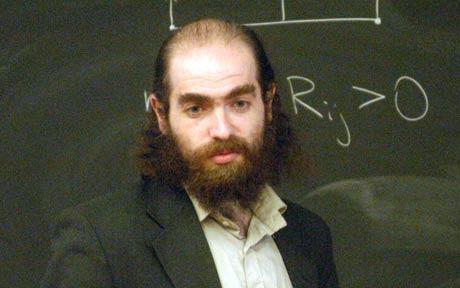<Back to Index>
- Mathematician Grogori Yakovlevich Perelman, 1966
PAGE SPONSOR


Grigori Yakovlevich Perelman (Russian: Григо́рий Я́ковлевич Перельма́н; born 13 June 1966) is a Russian mathematician who has made landmark contributions to Riemannian geometry and geometric topology.
In 1992, Perelman proved the soul conjecture. In 2002, he proved Thurston's geometrization conjecture. This consequently solved in the affirmative the Poincaré conjecture, posed in 1904, which before its solution was viewed as one of the most important and difficult open problems in topology.
In August 2006, Perelman was awarded the Fields Medal for "his contributions to geometry and his revolutionary insights into the analytical and geometric structure of the Ricci flow." Perelman declined to accept the award or to appear at the congress, stating: "I'm not interested in money or fame, I don't want to be on display like an animal in a zoo." On 22 December 2006, the journal Science recognized Perelman's proof of the Poincaré conjecture as the scientific "Breakthrough of the Year", the first such recognition in the area of mathematics.
On 18 March 2010, it was announced that he had met the criteria to receive the first Clay Millennium Prize for
resolution of the Poincaré conjecture. On July 1, 2010, he
turned down the prize, saying that he considers his contribution to
proving the Poincaré conjecture to be no greater than that of
U.S. mathematician Richard Hamilton, who introduced the theory of Ricci flow with the aim of attacking the geometrization conjecture.
Grigori Perelman was born in Leningrad, Soviet Union (now Saint Petersburg, Russia) on 13 June 1966, to Jewish parents, Yakov (who now lives in Israel) and Lubov. Grigori's mother Lubov gave up graduate work in mathematics to raise him. Grigori's mathematical talent became apparent at the age of ten, and his mother enrolled him in Sergei Rukshin's after - school math training program.
His mathematical education continued at the Leningrad Secondary School #239, a specialized school with advanced mathematics and physics programs. Grigori excelled in all subjects except physical education. In 1982, as a member of the Soviet Union team competing in the International Mathematical Olympiad, an international competition for high school students, he won a gold medal, achieving a perfect score. In the late 1980s, Perelman went on to earn a Candidate of Sciences degree (the Soviet equivalent to the Ph.D.) at the School of Mathematics and Mechanics of the Leningrad State University, one of the leading universities in the former Soviet Union. His dissertation was titled "Saddle surfaces in Euclidean spaces."
After graduation, Perelman began work at the renowned Leningrad Department of Steklov Institute of Mathematics of the USSR Academy of Sciences, where his advisors were Aleksandr Aleksandrov and Yuri Burago. In the late 1980s and early 1990s, Perelman held research positions at several universities in the United States. In 1991 Perelman won the Young Mathematician Prize of the St. Petersburg Mathematical Society for his work on Aleksandrov's spaces of curvature bounded from below. In 1992, he was invited to spend a semester each at the Courant Institute in New York University and State University of New York at Stony Brook where he began work on manifolds with lower bounds on Ricci curvature. From there, he accepted a two - year Miller Research Fellowship at the University of California, Berkeley, in 1993. After having proved the soul conjecture in 1994, he was offered jobs at several top universities in the US, including Princeton and Stanford, but he rejected them all and returned to the Steklov Institute in Saint Petersburg in the summer of 1995 for a research - only position.
He has a younger sister, Elena, who is also a scientist. She received a Ph.D. from Weizmann Institute of Science in Israel and is a biostatistician at Karolinska Institutet, in Stockholm, Sweden.
Perelman is also a talented violinist and a strong table tennis player.
Until the autumn of 2002, Perelman was best known for his work in comparison theorems in Riemannian geometry. Among his notable achievements was a short and elegant proof of the soul conjecture.
The Poincaré conjecture, proposed by French mathematician Henri Poincaré in 1904, was the most famous open problem in topology. Any loop on a three - dimensional sphere — as exemplified by the set of points at a distance of 1 from the origin in four - dimensional Euclidean space — can be contracted to a point. The Poincaré conjecture asserts that any closed three - dimensional manifold such that any loop can be contracted to a point is topologically a three - dimensional sphere. The analogous result has been known to be true in dimensions greater than or equal to five since 1960 (work of Stephen Smale). The four - dimensional case resisted longer, finally being solved in 1982 by Michael Freedman. But the case of three - manifolds turned out to be the hardest of them all. Roughly speaking, this is because in topologically manipulating a three-manifold, there are too few dimensions to move "problematic regions" out of the way without interfering with something else.
In 1999, the Clay Mathematics Institute announced the Millennium Prize Problems:
$1,000,000 prizes for the proof of any of seven conjectures, including
the Poincaré conjecture. There was a wide agreement that a
successful proof of any of these would constitute a landmark event in
the history of mathematics.
In November 2002, Perelman posted the first of a series of eprints to the arXiv, in which he claimed to have outlined a proof of the geometrization conjecture, of which the Poincaré conjecture is a particular case.
Perelman modified Richard Hamilton's program for a proof of the conjecture, in which the central idea is the notion of the Ricci flow. Hamilton's basic idea is to formulate a "dynamical process" in which a given three - manifold is geometrically distorted, such that this distortion process is governed by a differential equation analogous to the heat equation. The heat equation describes the behavior of scalar quantities such as temperature; it ensures that concentrations of elevated temperature will spread out until a uniform temperature is achieved throughout an object. Similarly, the Ricci flow describes the behavior of a tensorial quantity, the Ricci curvature tensor. Hamilton's hope was that under the Ricci flow, concentrations of large curvature will spread out until a uniform curvature is achieved over the entire three - manifold. If so, if one starts with any three - manifold and lets the Ricci flow occur, eventually one should in principle obtain a kind of "normal form". According to William Thurston, this normal form must take one of a small number of possibilities, each having a different kind of geometry, called Thurston model geometries.
This is similar to formulating a dynamical process that gradually "perturbs" a given square matrix, and that is guaranteed to result after a finite time in its rational canonical form.
Hamilton's idea attracted a great deal of attention, but no one could prove that the process would not be impeded by developing "singularities", until Perelman's eprints sketched a program for overcoming these obstacles. According to Perelman, a modification of the standard Ricci flow, called Ricci flow with surgery, can systematically excise singular regions as they develop, in a controlled way.
We
know that singularities (including those that, roughly speaking, occur
after the flow has continued for an infinite amount of time) must occur
in many cases. However, any singularity that develops in a finite time
is essentially a "pinching" along certain spheres corresponding to the prime decomposition of the 3-manifold. Furthermore, any "infinite time" singularities result from certain collapsing pieces of the JSJ decomposition. Perelman's work proves this claim and thus proves the geometrization conjecture.
Since 2003, Perelman's program has attracted increasing attention from the mathematical community. In April 2003, he accepted an invitation to visit Massachusetts Institute of Technology, Princeton University, State University of New York at Stony Brook, Columbia University and New York University, where he gave a series of talks on his work.
Three independent groups of scholars have verified that Perelman's papers contain all the essentials for a complete proof of the geometrization conjecture:
- On 25 May 2006, Bruce Kleiner and John Lott, both of the University of Michigan, posted a paper on arXiv that fills in the details of Perelman's proof of the Geometrization conjecture. John Lott said in ICM2006, "It has taken us some time to examine Perelman's work. This is partly due to the originality of Perelman's work and partly to the technical sophistication of his arguments. All indications are that his arguments are correct."
- In June 2006, the Asian Journal of Mathematics published a paper by Zhu Xiping of Sun Yat-sen University in China and Huai-Dong Cao of Lehigh University in Pennsylvania,
giving a complete description of Perelman's proof of the
Poincaré and the geometrization conjectures. The June 2006 paper
claimed: "This proof should be considered as the crowning achievement of
the Hamilton - Perelman theory of Ricci flow."
- In November 2006, Cao and Zhu published an erratum disclosing that they had failed to cite properly the previous work of Kleiner and Lott published in 2003. In the same issue, the AJM editorial board issued an apology for what it called "incautions" in the Cao – Zhu paper.
- On December 3, 2006, Cao and Zhu retracted the original version of their paper, which was titled “A Complete Proof of the Poincaré and Geometrization Conjectures — Application of the Hamilton – Perelman Theory of the Ricci Flow” and posted a revised version, renamed, more modestly, "Hamilton – Perelman's Proof of the Poincaré Conjecture and the Geometrization Conjecture". Rather than the grand claim of the original abstract, "we give a complete proof", suggesting the proof is by the authors, the revised abstract states: "we give a detailed exposition of a complete proof". The authors also removed the phrase "crowning achievement" from the abstract.
- In July 2006, John Morgan of Columbia University and Gang Tian of the Massachusetts Institute of Technology posted a paper on the arXiv titled, "Ricci Flow and the Poincaré Conjecture". In this paper, they provide a detailed version of Perelman's proof of the Poincaré conjecture. On 24 August 2006, Morgan delivered a lecture at the ICM in Madrid on the Poincaré conjecture. This was followed up with the paper on the arXiv, "Completion of the Proof of the Geometrization Conjecture" on 24 September 2008.
In May 2006, a committee of nine mathematicians voted to award Perelman a Fields Medal for his work on the Poincaré conjecture. The Fields Medal is the highest award in mathematics; two to four medals are awarded every four years. However, Perelman declined to accept the prize. Sir John Ball, president of the International Mathematical Union, approached Perelman in Saint Petersburg in June 2006 to persuade him to accept the prize. After 10 hours of persuasion over two days, Ball gave up. Two weeks later, Perelman summed up the conversation as follows: "He proposed to me three alternatives: accept and come; accept and don't come, and we will send you the medal later; third, I don't accept the prize. From the very beginning, I told him I have chosen the third one... [the prize] was completely irrelevant for me. Everybody understood that if the proof is correct, then no other recognition is needed." "'I'm not interested in money or fame,' he is quoted to have said at the time. 'I don't want to be on display like an animal in a zoo. I'm not a hero of mathematics. I'm not even that successful; that is why I don't want to have everybody looking at me.'" Nevertheless, on 22 August 2006, Perelman was publicly offered the medal at the International Congress of Mathematicians in Madrid "for his contributions to geometry and his revolutionary insights into the analytical and geometric structure of the Ricci flow." He did not attend the ceremony, and declined to accept the medal, making him the first person to decline this prestigious prize.
He had previously turned down a prestigious prize from the European Mathematical Society, allegedly saying that he felt the prize committee was unqualified to assess his work, even positively.
On 18 March 2010, Perelman was awarded a Millennium Prize for solving the problem. On June 8, 2010, he did not attend a ceremony in his honor at the Institut Océanographique, Paris, to accept his $1 million prize. According to Interfax, Perelman refused to accept the Millennium prize in July 2010. He considered the decision of Clay Institute unfair for not sharing the prize with Richard Hamilton, and stated that "the main reason is my disagreement with the organized mathematical community. I don't like their decisions, I consider them unjust."
Perelman's proof was rated one of the top cited articles in Math - Physics in 2008.
As of the spring of 2003, Perelman no longer worked at the Steklov Institute. His friends are said to have stated that he currently finds mathematics a painful topic to discuss; some even say that he has abandoned mathematics entirely. According to a 2006 interview, Perelman was then unemployed, living with his mother in Saint Petersburg.
Perelman is quoted in an article in The New Yorker saying that he is disappointed with the ethical standards of the field of mathematics. The article implies that Perelman refers particularly to the efforts of Fields medalist Shing - Tung Yau to downplay Perelman's role in the proof and play up the work of Cao and Zhu. Perelman added, "I can't say I'm outraged. Other people do worse. Of course, there are many mathematicians who are more or less honest. But almost all of them are conformists. They are more or less honest, but they tolerate those who are not honest." He has also said that "It is not people who break ethical standards who are regarded as aliens. It is people like me who are isolated."
This, combined with the possibility of being awarded a Fields medal, led him to quit professional mathematics. He has said that "As long as I was not conspicuous, I had a choice. Either to make some ugly thing or, if I didn't do this kind of thing, to be treated as a pet. Now, when I become a very conspicuous person, I cannot stay a pet and say nothing. That is why I had to quit." (The New Yorker authors explained Perelman's reference to "some ugly thing" as "a fuss" on Perelman's part about the ethical breaches he perceived).
It
is uncertain whether his resignation from Steklov and subsequent
seclusion mean that he has ceased to practice mathematics. Fellow
countryman and mathematician Yakov Eliashberg said
that, in 2007, Perelman confided to him that he was working on other
things but it was too premature to talk about it. He is said to have
been interested in the past in the Navier – Stokes equations and the set of problems related to them that also constitutes a Millennium Prize, and there has been speculation that he may be working on them now.
Perelman avoided journalists and other media people. Masha Gessen, the author of a book about him, found it challenging to write about a person she never met.
A recent Russian documentary about Perelman in which his work is discussed by several leading mathematicians including Mikhail Gromov was released in 2011 under the title "Иноходец. Урок Перельмана", "A pacer. A lesson from Perelman".
In April 2011 Aleksandr Zabrovsky, producer of "President - Film" studio, claimed to have held an interview with Perelman and agreed to shoot a film about him, under the tentative title The Formula of the Universe. Zabrovsky says that in the interview, Perelman explained why he rejected the one million prize:
I've learned how to calculate the voids; along with my colleagues we are getting to know the mechanisms for filling in the social and economic "voids". Voids are everywhere. They can be calculated, and this gives us great opportunities ... I know how to control the Universe. So tell me — why should I chase a million?
A number of journalists believe that Zabrovky's interview is most likely a fake, pointing to contradictions in statements supposedly made by Perelman.

